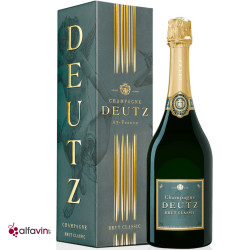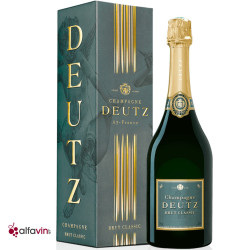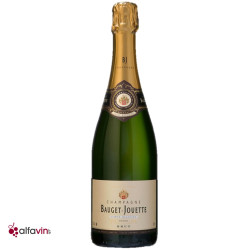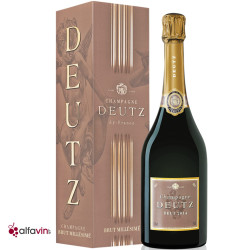- Home >
- Blog >
- advice-champagne-sparkling-wines >
- How is champagne made?
Knowing how this wine is made is a good step in learning about wines and developing one's knowledge. This is especially true since champagne and its production process are unique in the world of wine, so understanding it allows you to better interpret what you have in your glass and to analyze the differences that may exist. Before going further and explaining champagne, from the vineyards to the bottling, let's go back to the history of this mythical wine. The paternity is due to Dom Pérignon towards the end of the 17th century. He was the first to work on the regular and controlled foaming. Later, the hard work and solidarity of several Champagne winemakers as well as the work of Louis Pasteur on fermentation, will make champagne what it is today.
Where is champagne produced?
The Champagne appellation is surely one of the most protected appellations. The Champagne region is located northeast of Paris, about 2 hours from the center of the capital. The Champagne wine region covers an area of 34,000 ha and is divided into four areas:
the Montagne de Reims, the Côte des Blancs, the Vallée de la Marne and the Côte des Bar. The AOC includes 319 crus (communes) of which seventeen are classified as grand crus and forty-two as premiers crus. The Montagne de Reims stretches from west to east for about thirty kilometers and is six to ten kilometers wide. The Marne Valley is located south of the Reims Mountain between Charly-sur-Marne to the west and Epernay to the east. The vineyard clings to the hillsides on either side of the meandering Marne. A few kilometers south of Epernay is the prestigious Côte des Blancs with 4 grands crus: Avize, Cramant, Le Mesnil-sur-Oger and Oger. Finally, the Côte des Bar, located south-east of Troyes, is the last wine-producing area of Champagne. It has the particularity of being an important geological mosaic for the other producing regions. It is the only one not to have any great growths within it.
Which grapes are used to produce champagne?
To be able to produce and sell its wine under the AOC Champagne, the winegrowers and champagne houses have the obligation to use only three grape varieties:
Pinot Noir, Chardonnay and Pinot Meunier. After the passage of phylloxera, a vine disease that destroyed the majority of the world's vineyards, the winegrowers had to use rootstocks capable of resisting this disease. In the subdivision of the Montagne de Reims, we find mainly Pinot Noir, followed by Pinot Meunier and some Chardonnay. They bring structure to the wine. On the other side of this mountain, in the Marne Valley, the Pinot Meunier is this time in majority at almost 60%, followed by the Pinot Noir and the Chardonnay. Here the wines are a bit full-bodied with a nice freshness. As for the Côte des Blancs, it bears its name well. Here the Chardonnay reigns supreme with more than 80% of the surface area occupied. The wines bring finesse and elegance, and are often used in prestigious vintages. Finally, the subdivision of the Côte des Bars is planted mainly with Pinot Noir which gives softer wines, generally used in the blends of the great champagne houses.
What are the stages of champagne production?
Better known as the
méthode champenoise or traditional method, the elaboration of champagne follows strict rules, marks of its excellence. The work in the vineyards being quite similar to what can be done in other regions, we start directly with a crucial and determining step.
The Harvest: From the vines to the plots, the grape varieties reach the desired maturity at different dates. In this sense, the date of the harvest is variable from one vintage to another. To define the right date of harvest, a panel of 404 plots, representative of the whole appellation, has been set up in order to control the ripeness as it happens. It should be noted that the harvest is done on the date transmitted to the authorities. Non-compliance can lead to the downgrading of the entire harvest and thus lose the AOC Champagne on the vintage. The harvest of a plot of land must be done at once to ensure the homogeneity of the quality and is done exclusively by hand. The bunches are placed in small baskets of 3 to 4 kg maximum in order not to crush them. At the end of the plot, the bunches are placed in perforated boxes to allow the aeration of the berries and avoid the maceration of the juice.
Pressing: Once the plot is harvested, the grapes are brought to the pressing center. This step consists in collecting the juice by crushing the grapes. In order to ensure quality, the waiting time of the harvest before this operation does not exceed 6 to 8 hours. The pressing is done slowly, the aim being to extract only the white juices and to avoid the extraction of the color. The specifications impose a yield of 102 liters of juice for 160 kg of pressed grapes. The extraction of the juice is divided so that 20.50 hectoliters constitute what is called "La Cuvée" and 5 hectoliters "La Taille". Note that generally, the grapes for the vintages are pressed separately from each other to ensure optimal quality.
Vinification: Before fermentation, certain phases may be necessary to "correct" the must. The chaptalization is a process that allows the addition of sugar (cane or beet sugar) when the grapes are not ripe. Please note that the maximum alcohol level allowed in champagne is 13°. The control of the natural acidity can be regulated with the malolactic fermentation which results in a decrease of the acidity. Finally, the yeast is the step that allows the transformation of sugar into alcohol. Naturally present in the wine, the yeasts are sometimes insufficient for the fermentation to take place, so selected and raised yeasts are added (either by the producers themselves or by the CIVC). Then comes the alcoholic fermentation, whose action is to transform the sugars into alcohol through yeast. When all the sugar is transformed into alcohol, the fermentation is finished, the wines are then clarified to keep only the juice and remove the remaining particles (lees). If the acidity levels are too high, the producers have the possibility of carrying out a second fermentation, called malolactic fermentation. The malic acids are transformed into lactic acids and allow the reduction of this rate.
Blending: This is a very important step since it involves blending the still wines in order to always obtain the same champagne from one year to the next and which defines the style of the house. In order to do this and depending on the vintage, the cellar master blends different grape varieties with different vintages and different plots to obtain this harmony and regularity.
The Bottling is the next step. This process is also called "champagnisation" because of its specificity to champagne. It consists in bottling the wines with a tirage liqueur (sugar + yeast). The quantity of liqueur added is calculated on the basis of 24g per liter to obtain 6 kg per cm2 of pressure for the prise de mousse.
Then
the Sparkling process can start. Once the bottles are drawn, they are placed on slats for what is called the "prise de mousse". Also called the second alcoholic fermentation, this one takes place in the bottle thanks to the action of the yeasts on the sugar which creates a light carbonic gas. This operation takes place in cellars at a constant temperature between 9 and 12°C. The cooler the temperature, the more rapid the fermentation and the less the quality of the foam.
Then comes
the Riddling and Disgorging phases. Once the second fermentation is over, the wines are stirred so that from the lying down state, the bottles end up standing upright (upside down). The wines are stirred regularly to bring down the deposit accumulated during fermentation into the cork with a receptacle (called bidule). Once upright, the disgorging can begin. If in the past, this operation was done "on the fly", it is now done with the help of machines. The bottle necks are plunged into a brine tank (liquid at -25°C). The neck with the cork and its thingy are frozen. The frozen corks are then blown up to retain the deposit accumulated in the canister.
The last step of the manufacturing process is
the Bottling with what is called the expedition liquor. Once disgorged, the bottles lose a little liquid. They are therefore supplemented by this liqueur composed of wines known as reserves (at least two years) assembled with sugar. It is this liqueur that will define the dosage and thus give the categories that we find below:
Brut Nature: less than 3 grams per liter.
Extra Brut: between 0 and 6 grams per liter.
Brut: less than 12 grams per liter.
Extra dry: between 12 and 17 grams per liter.
Dry: between 17 and 32 grams per liter.
Demi-sec: between 32 and 50 grams per liter.
Sweet: more than 50 grams per liter.
The addition of this liqueur cannot exceed 5 or 6 cl.
How are champagne bubbles formed?
Strictly speaking, champagne does not contain bubbles. For example, if you take a glass that has no micro-dust or asperities, the bubble will never appear. Indeed, it is in contact with these micro-dust or asperities that the carbonic gas dissolved in the wine is transformed into bubbles. The carbon dioxide appears during the second fermentation. The transformation of sugar into alcohol by the yeasts will create this carbon dioxide which will naturally dissolve in the bottle.
You now have all the cards in hand to explain champagne and its process around you. Don't hesitate to visit the CIVC website (Comité Interprofessionnel des Vins de Champagne) to get more information.
Discover our articles on champagne:The best Italian ProseccoWhat is the difference between a sparkling wine, a cremant and a champagne?How is sparkling wine is made5 ideas for aperitif cocktails with champagneFood and champagne pairing: what to eat with champagne?Our wines linked to this post

49.00 CHF

105.00 CHF

36.00 CHF

66.00 CHF










